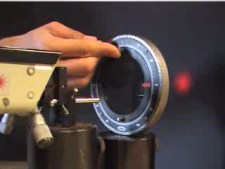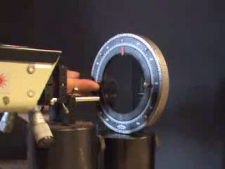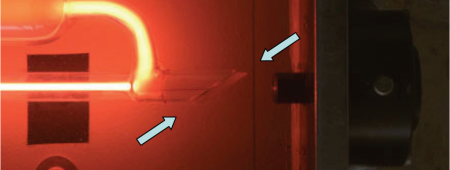2. Laser
Polarisation
One distinctive feature of the HeNe lasers is the polarisation of the laser light. In the images below, the light beam is magnified by a lens and passes through a polarising filter. Its transmitting orientation is indicated by the red arrow. Light that is polarised in this orientation is allowed by the filter to pass through, while light that is polarised vertically is blocked.


Have a look at the experiment in a Video (500 kB).
In the previous page, it was made clear that resonance in the laser can be easily disrupted through absorption loss. This is the reason why the ends of the discharge tube should be as permeable as possible. This can be achieved by using a so-called Brewster windows. These are windows tilted at Brewster’s angle which is a 56° incidence angle in air for an air-glass interface.
No reflection takes place when, parallel to the plane of incidence polarised light (horizontally-polarised light in the present case) falls on a window tilted at Brewster's angle. What takes place is a complete transmission which then builds up aresonance with lowest possible losses. Hence, the laser emits horizontally polarised light because the Brewster-window is tilted vertically.

Light can only be amplified when the process of induced emission has a higher probability than absorption. This is achieved by circumventing the thermodynamic equilibrium which forbids this probability. The method called pumping makes population inversion possible.
A resonator is used in bringing the emitted waves (photons) to interfere constructively with one another. A laser can work continuously when a part of this resonance is extracted.
The HeNe laser used in this tutorial produces polarised light owing to the Brewster windows in the resonator.
